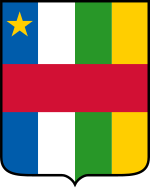Coat of arms of the Central African Republic
| Coat of arms of the Central African Republic | |
|---|---|

|
|
| Details | |
| Introduced | 1963 |
| Motto (motto) | Unité - Dignité - Travail ( French : "Unity - Dignity - Work") Zo Kwe Zo ( Sango : "Every person is a person") |
| Previous versions |
|
The coat of arms of the Central African Republic was introduced under President David Dacko in 1963 , three years after the independence from France was declared.
description
In the center of the coat of arms is an almost square, quartered shield. The individual fields of the sign are designed as follows:
- At the top right you can see a white elephant on a green background.
- To the left of it is a green baobab tree on a white background.
- At the bottom right on a yellow background three four-pointed white stars that form an equilateral triangle standing on the edge.
- The fourth quarter is dark blue with a red-brown hand on it pointing towards the center of the shield.
- On all of them there is a red square heart shield with a white border ; Inside on a white circle in black the map of Africa, above a five-pointed yellow star.
The shield is flanked on the right and left by a flag of the Central African Republic , on top of which there is also a yellow, semicircular sun. A medal of honor can be seen below the shield.
The top and bottom of the coat of arms form two banners. The upper banner reads in Sango :
- " Zo Kwe Zo "
- ( Every human is human )
The lower banner reads in French :
- " Unité - Dignité - Travail "
- ( Unity - dignity - work )
symbolism
The elephant and the baobab represent the natural environment and the economic backbone of the country.
While the red-brown hand is the symbol of MESAN , the political party that was in power when the coat of arms was introduced, the three stars are supposed to symbolize the country's diamond wealth.
The fifth, central field represents the country's central location on the African continent.
The 14 prefectures, two economic prefectures and the autonomous city of Bangui can be found in the 17 rays of the sun.
literature
- Karl-Heinz Hesmer: Flags and coats of arms of the world. History and symbolism of the flags and coats of arms of all states. Bertelsmann Lexikon Verlag, Gütersloh 1992, ISBN 3-570-01082-1 .
Web links
- Flag lexicon (description of flag and coat of arms)
